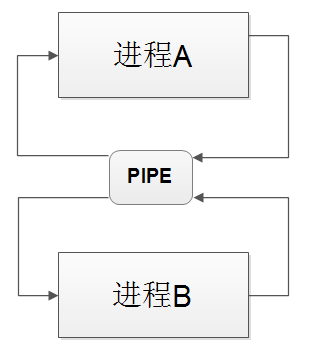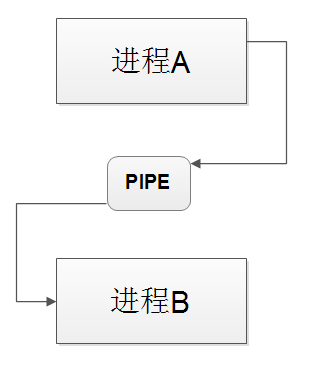管道简介
管道顾名思义类似于我们生活中的水管,只不过其中流动的是“数据”或者说一个一个字节,只能单向流动的我们称为“半双工”,能双向流动的称为“全双工”,其有两个端点,数据流入的那一端称为“写端”,反之则称为“读端”,这两个端点实际上是两个“描述字”。这样的管道可以连接在两个进程之间,成为数据传输的通道。如下图所示:

若pipe为无名管道,则进程A和进程B具有父子关系,若A,B没有父子关系则pipe为命名管道!从上图可以看到A,B进程都可以对管道进行读写,通常情况是一个进程写入,另一个进程读出。进程端可以根据需要关闭pipe的写/读端,如下图所示:
非命名管道
#include <stdio.h>
#include <unistd.h>
#include <string.h>
#include <stdlib.h>
#define BUFF_SZ 256
int main()
{
printf("app start...\n");
pid_t pid;
int pipe_fd[2];
char buf[BUFF_SZ];
const char data[] = "hi, this is the test data";
int bytes_read;
int bytes_write;
//clear buffer, all bytes as 0
memset(buf, 0, sizeof(buf));
//creat pipe
if(pipe(pipe_fd) < 0)
{
printf("[ERROR] can not create pipe\n");
exit(1);
}
//fork an new process
if(0 == (pid=fork()))
{
//close the write-point of pipe in child process
close(pipe_fd[1]);
//read bytes from read-point of pipe in child process
if((bytes_read = read(pipe_fd[0], buf, BUFF_SZ)) > 0)
{
printf("%d bytes read from pipe : '%s'\n", bytes_read, buf);
}
//close read-point of pipe in child process
close(pipe_fd[0]);
exit(0);
}
//close read-point of pipe in parent process
close(pipe_fd[0]);
//write bytes to write-point of pipe in parent process
if((bytes_write = write(pipe_fd[1], data, strlen(data))))
{
printf("%d bytes wrote to pipe : '%s'\n", bytes_write, data);
}
//close write-point of pipe in parent process
close(pipe_fd[1]);
//wait child process exit
waitpid(pid, NULL, 0);
printf("app end\n");
return 0;
}命名管道(fifo)
创建命名管道
我们可以使用两下函数之一来创建一个命名管道,他们的原型如下:
#include <sys/types.h>
#include <sys/stat.h>
int mkfifo(const char *filename, mode_t mode);
int mknod(const char *filename, mode_t mode | S_IFIFO, (dev_t)0); 这两个函数都能创建一个FIFO文件,注意是创建一个真实存在于文件系统中的文件,filename指定了文件名,而mode则指定了文件的读写权限。
mknod是比较老的函数,而使用mkfifo函数更加简单和规范,所以尽量使用mkfifo而不是mknod。
访问命名管道
- 打开创建的管道
与打开其他文件一样,FIFO文件也可以使用open调用来打开。打开FIFO文件通常有四种方式,分别如下:
open(const char *path, O_RDONLY);//阻塞读
open(const char *path, O_RDONLY | O_NONBLOCK);//非阻塞读
open(const char *path, O_WRONLY);//阻塞写
open(const char *path, O_WRONLY | O_NONBLOCK);//非阻塞写注意:1、程序不能以O_RDWR模式打开FIFO文件进行读写操作,而其行为也未明确定义,因为如一个管道以读/写方式打开,进程就会读回自己的输出,同时我们通常使用FIFO只是为了单向的数据传递。2、传递给open调用的是FIFO的完整路径名。
- 对管道进行读写
和普通的文件读写一致。
命名管道实列
先创建一个进程A,其负责创建FIFO管道,读取pipeA.c的数据,通过创建的FIFO通道将读取的数据发送给进程B:
/*
* file :pipeA.C
*/
#include <unistd.h>
#include <stdlib.h>
#include <fcntl.h>
#include <limits.h>
#include <sys/types.h>
#include <sys/stat.h>
#include <stdio.h>
#include <string.h>
int main()
{
const char *fifo_name = "/tmp/my_fifo";
int pipe_fd = -1;
int data_fd = -1;
int res = 0;
const int open_mode = O_WRONLY;
int bytes_sent = 0;
char buffer[PIPE_BUF + 1];
if(access(fifo_name, F_OK) == -1)
{
//管道文件不存在
//创建命名管道
res = mkfifo(fifo_name, 0777);
if(res != 0)
{
fprintf(stderr, "Could not create fifo %s\n", fifo_name);
exit(EXIT_FAILURE);
}
}
printf("Process %d opening FIFO O_WRONLY\n", getpid());
//以只写阻塞方式打开FIFO文件,以只读方式打开数据文件
pipe_fd = open(fifo_name, open_mode);
data_fd = open("pipeA.c", O_RDONLY);
printf("Process %d result %d\n", getpid(), pipe_fd);
if(pipe_fd != -1)
{
int bytes_read = 0;
//向数据文件读取数据
bytes_read = read(data_fd, buffer, PIPE_BUF);
buffer[bytes_read] = '\0';
while(bytes_read > 0)
{
//向FIFO文件写数据
res = write(pipe_fd, buffer, bytes_read);
if(res == -1)
{
fprintf(stderr, "Write error on pipe\n");
exit(EXIT_FAILURE);
}
//累加写的字节数,并继续读取数据
bytes_sent += res;
bytes_read = read(data_fd, buffer, PIPE_BUF);
buffer[bytes_read] = '\0';
}
close(pipe_fd);
close(data_fd);
}
else
exit(EXIT_FAILURE);
printf("Process %d finished\n", getpid());
exit(EXIT_SUCCESS);
} 然后创建进程B,它从管道中读取数据并将读取的数据写入DataFormFIFO.txt文件。最终DataFormFIFO.txt应和pipeA.c内容一致:
/*
* file:pipeB.c
*/
#include <unistd.h>
#include <stdlib.h>
#include <stdio.h>
#include <fcntl.h>
#include <sys/types.h>
#include <sys/stat.h>
#include <limits.h>
#include <string.h>
int main()
{
const char *fifo_name = "/tmp/my_fifo";
int pipe_fd = -1;
int data_fd = -1;
int res = 0;
int open_mode = O_RDONLY;
char buffer[PIPE_BUF + 1];
int bytes_read = 0;
int bytes_write = 0;
//清空缓冲数组
memset(buffer, '\0', sizeof(buffer));
printf("Process %d opening FIFO O_RDONLY\n", getpid());
//以只读阻塞方式打开管道文件,注意与fifowrite.c文件中的FIFO同名
pipe_fd = open(fifo_name, open_mode);
//以只写方式创建保存数据的文件
data_fd = open("DataFormFIFO.txt", O_WRONLY|O_CREAT, 0644);
printf("Process %d result %d\n",getpid(), pipe_fd);
if(pipe_fd != -1)
{
do
{
//读取FIFO中的数据,并把它保存在文件DataFormFIFO.txt文件中
res = read(pipe_fd, buffer, PIPE_BUF);
bytes_write = write(data_fd, buffer, res);
bytes_read += res;
}while(res > 0);
close(pipe_fd);
close(data_fd);
}
else
exit(EXIT_FAILURE);
printf("Process %d finished, %d bytes read\n", getpid(), bytes_read);
exit(EXIT_SUCCESS);
} 运行程序便会发现,无论是先运行A或是B,先运行起来的都会等待另外一个,这时open函数第二个参数的原因,我们可以添加O_NONBLOCK选项来取消阻塞。























 416
416











 被折叠的 条评论
为什么被折叠?
被折叠的 条评论
为什么被折叠?








